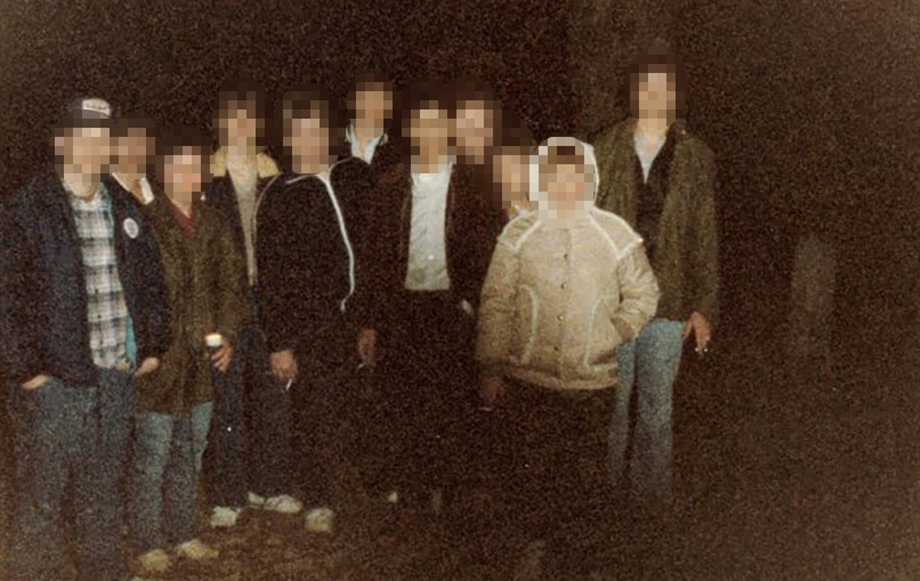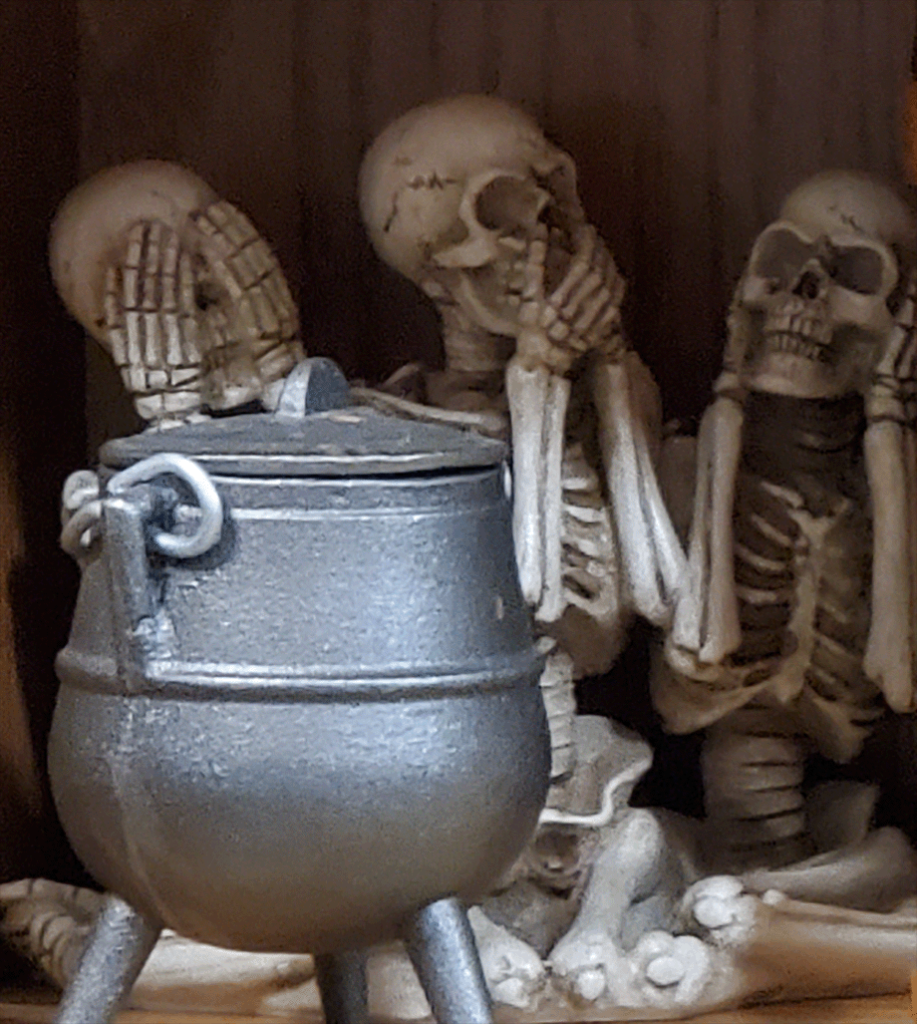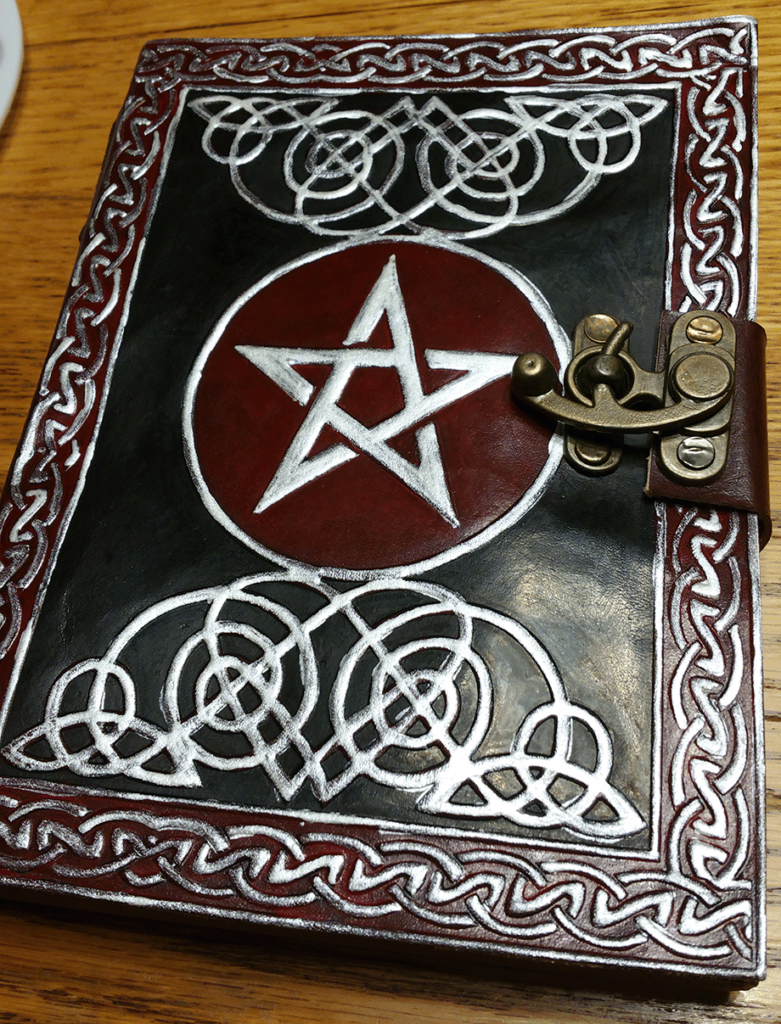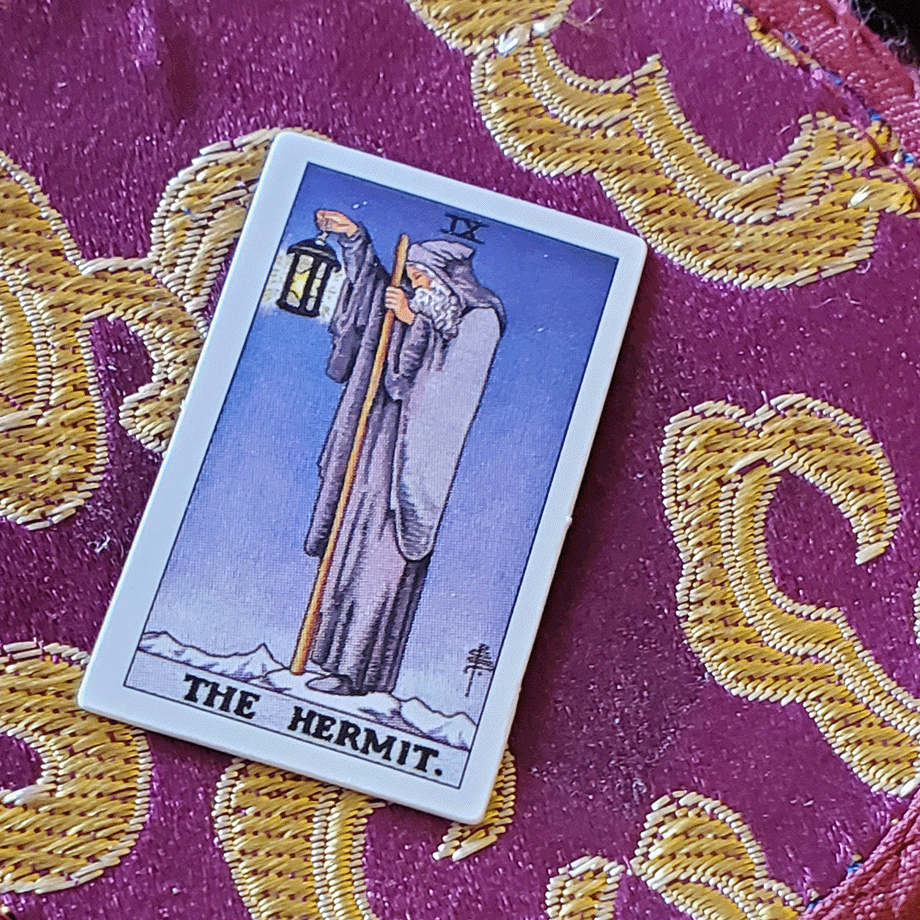Discretion is traditionally considered the better part of valor. Valor, however, is not something we use in common parlance, at least not in the New Millennium (more’s the pity).
Keeping one’s trap shut is frequently recommended, however, especially when it comes to things occult. Occult, after all, means hidden. This tradition was still largely extant in my youth. That was not so much due to oaths of silence, but to prevent the perception that one was some kind of kook. In the twenty-twenties, however, out and proud witchcraft screams across social media, into the mainstream shops, and horribly inaccurate television and film narratives.
I’m not entirely sure that’s a good thing.
Let’s scrape aside for a moment the Hollywood version of things. Let’s remove the layer upon layer of mass market paperbacks, most generated to cash in on a trend, and some not even written by human beings. Let’s try for a moment to encounter witchcraft, magic, and the occult without the glare of Facebook, Instagram, and TikTok (and Tumblr and Twitter and Toto too.)
What are we actually left with? What is the nature of occult practice today, without all the external public glitz and glamour?
I personally suspect that the circle is drawn considerably smaller. I am not opening the debate about what constitutes “a real witch” on ye olde Internet. I’m simply saying that a lot of what is out there is surface, and that the number who are swimming in deeper waters is more limited.
It’s fairly evident to me that occultists of my age are somewhat rare on the interwebs. I don’t think it’s because we made inadvisable pacts with infernal forces and were carried off at an untimely age to serve our nefarious masters.
Nor do I believe it likely that we are generationally impaired when it comes to technology. If you can tease out the important threads from a Medieval grimoire, I’m pretty sure you can handle tweeting from your mobile device.
It’s probably because that most of us are going on our merry way, hobnobbing with our brother wizards as per usual, without making a big thing out of it. We still ascribe to those old habits of long hours of hard studying, nigh scientific experimentation, and keeping the results of our efforts restricted to a close circle of intimates.
There are some things that I am never going to tell anyone.
I am bound by no oath. I am not a member of any secret society or tradition.
But there are still some things that I am never going to tell anyone.

I’ve been exploring a number of Tibetan traditions in the last year or so. I’ve been aware of them since I was a child, I think, but for many reasons these never seemed to “fit” my experience of the cosmos, until recently.
I’m one that generally bridles at the idea of the guru. in fairness, this is a response to the often poorly expressed and sometimes exploited image of the guru in the West. Looking up the term in Sanskrit, it translates generally to “one worthy of honor”.
Doesn’t say teacher, though that is implied. Doesn’t say holy one, mentor, buddha, etc. Just simply one worthy of honor.
I can get behind that idea.
I’ve met a number of people in life that I considered worthy of honor. Generally they had some impact on my way of thinking, or acting, or the choices I made in life as a consequence of meeting them. Very few of these encounters were with formal teachers, in a specific discipline or in an academic or meditative setting. Quite to the contrary, my experience with formal instruction was often frustrating and fruitless.
But still, in my late fifties, I was finding more and more connections with these old beliefs from the Himalayas and surrounding areas. Now, I have no intention of selling all that I own and joining a Tibetan monastery. For one thing, my wife would not be at all pleased with it, and I am rather fond of her. But the study of these ideas is accessible via the Internet, so I have the option of learning from home.
Or so I thought. Many of the texts I have read (and in fairness, they’re not a lot), make reference to an initiation ceremony of sorts, and of the need for direct instruction.
Now why would this be so? Isn’t the whole idea of Enlightenment as something that happens to one upon the spiritual path? Now there are gatekeepers to Nirvana?
Well, in a way yes. There are at least guides. There are people who have trod the path ahead of you, and know where you are liable to slip and fall. It is out of a concern for your safety that they offer the warning.
But sometimes the warning is insufficient. Sometimes, we are not able to hear the warning or understand it.
Let’s assume we are walking a terrestrial path in the woods. It twists and turns, and rambles over rough ground. Just up ahead, behind a bend in the road, there’s a hungry bear. If you have reached the bend in the road, you can see the bear, and see a path that will take you well clear of it.
But from where you are, you can’t see the bear waiting for you.
The person ahead can see it, tell you that it is there, and prepare you to react properly to it.
This is the idea of guru.
Someone doesn’t need to have made it to the end of the path. They just need to be far enough ahead of you to be helpful. The best teachers are themselves perpetual students.
But those who are further ahead on the path, realize that you not only don’t know about the bear, you don’t necessarily know what a bear is, or why it is dangerous. It is kinder for them to say, “You must wait here.” or “You must go that way”, than terrifying you with the idea that there’s a hungry bear in the woods waiting to eat you. Then you are only going to be worried about the bear. You’ll constantly be looking for the bear, and miss all the other wonderful and exciting things along the path.
Plus, you’ll probably never work up the courage to step off that path and go wandering in the woods.
The person ahead of you hopes that someday you will stand at that bend in the road, and gently beckon backward to those behind you and say “Here, come this way”. They will help you where they can, but they know that you still might be eaten by the bear. This is because no matter how much they may provide by way of instruction, there is always some things you must experience yourself in order to fully understand them.

Now since I am not going to Tibet anytime soon, I have to look at other ways to get around that bear. These may be “wrong” in the sense that they will lead me down paths that wind and twist and meet dead ends, forcing me to go back and find a better way. But I believe there is more than one way around the bear. After all, someone had to figure out how to get past it to begin with, so just because one way may be best, or easier, it doesn’t mean it’s the only way. Sometimes it’s not the best or easiest for the person making the journey.
The occult nature of occult studies in the West, was largely induced by the need to avoid the ecclesiastic and civil authorities who had enacted penalties for such practices. If you poke into the dark corners of the late Middle Ages you can find that the fear of the Holy Mother Church for the other Abrahamic religions may have led to any texts written in Hebrew or Arabic being considered books of Black Magic.
While in the Moorish kingdom of Cordoba, Jews were tolerated and allowed to live more or less normal lives, the rest of Europe considered them heretics. 1One of the ingredients in the witches brew from Shakespeare is “liver of blaspheming Jew”. While modern eyes see this as a gross anti-semitism, the Christian world of the 15th and 16th century regarded the Jewish denial of the Christ as the Messiah as strongest heresy. The Inquisition’s torture chambers were filled with more Jews than apostate Catholics, witches, and other “deviants”. Driven underground during the Reconquista, the Jews, remaining Muslims, and their libraries, may have been the impetus for the rumored Black School of Toledo. This establishment, supposedly in a system of caves and caverns north of the city, was the top wizard school of the age. Like Hogwart’s though, it didn’t really exist.
There were, of course, a great number of actual magical texts that came through the Moorish kingdom into Europe. One of the most famous is the Picatrix, a 12th century Latin translation of the 10th century Islamic Ghayat al-Hakim.
The Arabic name translates roughly to “The Goal of the Sage”. It is an encyclopedic reference on various spells, potions, rituals, enchantments, talismans, and conjurations. The bones of this likely filtered down into works by Paracelsus and Agrippa, and were known to people like John Dee, Francis Bacon, Michel de Notre Dame, and later occult researchers of the Renaissance and Baroque periods through their work. it is not impossible that much of the ceremonial magic practiced today has roots in the Ghayat al-Hakim.
The Greek Magical Papyri also made their way into Europe by way of Islam, either through Spain or via the Silk Road. Practices and belief from as far away as China made that journey, and were synthesized, augmented, and mutated all along the way westward. The “Black Magic” being suppressed by the church was a complicated polyglot of folk-belief, surviving ancient practices, and the influence of esoteric concepts from Africa, Arabia, and Asia.
Growing hand in hand with the secular humanism of the Renaissance, occult ideas were mutated again into being Christian magic and Holy Alchemy. The reasoning was simple and convenient. The “spirits” which could include angels, demons, djinn, efrit, fae, nature spirits, the dead, and the old gods, had all be made by the Lord God Jehovah who had given Man dominion over all things way back in the Book of Genesis. Ergo, Man could dominate those beings, and use them as he saw fit, like some supernatural twenty-mule team. At least, that’s how it looked on paper.
In reality, if one were well-heeled and well-placed, dabbling in sorcery was an accepted hobby. Divination and necromancy were supported by an elite looking for financial or political advantage. Alchemy offered both immortality and tremendous wealth, so it is not surprising that even kings funded these obscure experiments.

The Victorian lodge magicians set a great store by grimoires and their black books. Traditional witches prior to Wicca likely passed down most of what they knew by oral tradition, or at most a recipe book of herbal cures, and potions.
Much as been made of the odd symbology that surrounds alchemy. These images were a kind of secret code, to keep the unwise from finding the Philosopher’s Stone and using it for impure purpose. The adept -as the alchemists were fond of calling themselves – was able to decipher the code into a kind of manufacturing process, aimed at creating the Stone and/or the Elixir of Life. Some texts say the Stone makes the Elixir. Some say the Elixir may be boiled away to make the Stone. The Stone, of course, turned lead in to gold, which was the primary goal of the investors. Immortality would be a great bonus, but immortality without the money to enjoy it was a non-starter.
Many researchers today think that the alchemical manuscripts were obfuscating a philosophical journey, whereby the individual purified their own soul and consciousness, thereby earning eternal life (spiritually or physically is not clear, though there are legends of those who attained to great old age through the process).
This brought to my mind some of those Tibetan concepts I have been working with. The mandalas and related imagery are often confusing. In some cases they would appear terrifying and even pornographic to Western eyes. Yet I understand these to be a complex symbolic language, aimed at teaching key points that aid in spiritual growth.
Sound familiar?
I obtained a copy of the Bardo Thodol when I was in my teens. This is known by the more popular title of the Tibetan Book of the Dead. It’s been a while since I read it, but I do recall it was about giving instructions so that the soul could be purified, and escape the endless cycle of physical reincarnation. If that wasn’t possible, then the goal was to find a new body which would be best suited to educate you for the next round. Because at birth, we tend to forget those things we learned in the previous life, and only by transcending the illusion of physicality can we reach those other memories.
Buddha said “We have all lived a thousand lifetimes. I remember all of them and you remember only this one. ” Consider that for a moment. Think about all the things that your current life experience has been. You hopefully have had joy and love. But we all have experienced pain and loss. Now multiply those memories by ten, or a hundred, or a thousand. Can you conceive of the joy you could feel if you accessed that? Can you imagine the pain of all those memories; the lost loved ones, the disappointments, the fear.
That’s the hungry bear waiting out there in the woods.
Realizing that this is not about balancing the good against the bad, or joy over the pain, is not something we typically do in the West. Duality is a big part of our nature, and it goes very far back. The nature of Other is built into our experience of the Universe. To be able to recognize the Universe is to acknowledge the Other. Yet all things are either Other or us, and as we are Other to the Other, it’s all the same thing. The forms and shapes are just paint and wallpaper on the real nature of the Cosmos.
Grasping that inside a human brain is nigh impossible. It’s hard to say if the Buddhas of Eastern thought actually attained it in physical form, or transcended, and having transcended, chose to return to their bodies to function as guides and teachers. 2There may be parallels in the Christian story of Jesus.
Having transcended the physical, it’s insubstantiality is understood. It is not real. Changing it is like switching channels. Not happy with your job? Click. Looking for a better apartment.? Click. Want to move that mountain range? Click.
Which is precisely why such capacities have been kept from the unwise, the untrained, and the uninitiated. That sort of thing could be very dangerous. We can’t have people going around and moving mountains. Think of the consequences.
Thing is, when you can move a mountain, you realize that you need not do it. There’s no reason. It’s just a mountain. There’s more important things you can put your power toward.
But I can’t tell you about that.

Absent a view of the world around him, we may suppose he is holding the light to beckon others coming up the mountain. But he may also be holding a lamp unto his feet. The enigma of the Hermit reminds us that the path is potentially treacherous, even when we think we know it.
I appreciate your reading about what I could put into words, and of course, hope that it gave you some measure of perspective. The Hermit’s light shines through a crack in the lantern. The full force of it’s brightness is blinding.
And you don’t want to go wandering around blinded. There’s a hungry bear out there.

